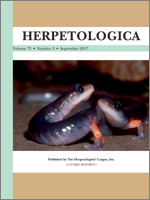Plethodontid salamanders exhibit biphasic, larval form paedomorphic, and direct developing life cycles. This diversity of developmental strategies exceeds that of any other family of terrestrial vertebrate. Here we compare patterns of larval development among the three divergent lineages of biphasic plethodontids and other salamanders. We discuss how patterns of life-cycle evolution and larval ecology might have produced a wide array of larval life histories. Compared with many other salamanders, most larval plethodontids have relatively slow growth rates and sometimes exceptionally long larval periods (up to 60 mo). Recent phylogenetic analyses of life-cycle evolution indicate that ancestral plethodontids were likely direct developers. If true, then biphasic and paedomorphic lineages might have been independently derived through different developmental mechanisms. Furthermore, biphasic plethodontids largely colonized stream habitats, which tend to have lower productivity than seasonally ephemeral ponds. Consistent with this, plethodontid larvae grow very slowly, and metamorphic timing does not appear to be strongly affected by growth history. On the basis of this, we speculate that feeding schedules and stress hormones might play a comparatively reduced role in governing the timing of metamorphosis of stream-dwelling salamanders, particularly plethodontids.
How to translate text using browser tools
1 September 2017
How Metamorphosis Is Different in Plethodontids: Larval Life History Perspectives on Life-Cycle Evolution
Christopher K. Beachy,
Travis J. Ryan,
Ronald M. Bonett
ACCESS THE FULL ARTICLE

Herpetologica
Vol. 73 • No. 3
September 2017
Vol. 73 • No. 3
September 2017
Corticosterone
direct development
growth
larva
paedomorphosis
thyroid hormones




